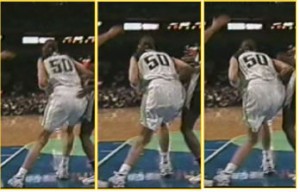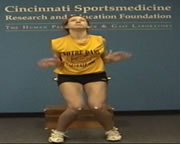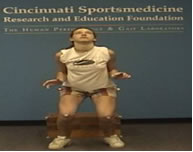ROD 040811
ROD
Friday, 08Apr11
Unfortunately the 10 & 11 am classes are cancelled. Due to circumstances beyond our control. The 5:30 am class is still scheduled.
Timed Pyrimad
- 30/20
- 40/20
- 50/10
- 40/20
- 30/20
Movements
- Reclines
- KB Cleans
- Swimmers
- Bag Jumps
- Bodybar get-ups
- Figure 8 to a hold
________________________________________________________________________
Why Young Females Tear ACL’s.. If you watch sports particulary girls sports whether it’s your adolecent teen daughter or all the way up to the professional level you’ve probaly seen your fair share of knee injuries especially the ACL. Before I get into just exactly what the ACL is and common problems umongst young female athletes it must be noted that 70% of all ACL injuries are NON-CONTACT!!
This is simply where the athlete is chasing down a soccer ball, moving laterally to reach for that softball up the middle, or landing from a jump to block that volley ball spike and then the next thing you know POP and they’re down in pain. What’s ironic is that they’re performing something that they’ve done from a skill or technique point hundreds if not thousands of times, but just this one time there happened to be and injury which could have been avoided. Take a look at the athlete below particulary her left knee.
Left ACL Tear
This is a tough caption to look at but it hopefully helps to drive home the point that female athletes are 5-6 times more suseptible to tear their ACL than there male counter part. To put it into perspective next time when you’re at your daughters practice one out of every 9 college females will tear their ACL every year. This is not good especially if it happens to be your daughter. FYI, the athlete pictured was a first round pick of the WNBA and unfortunatley this ended her promising young career.
Let’s take a look at why this happens and some different ways we can go and make this common injury more avoidable in female athletes.
COMMON RISK FACTORS IN ACL TEARS
Anatomical :
– Femoral notch size (lateral condylopatellar sulcus)
– Q-angle. This is where the athlete is “knock kneed” Also known as valgus alignment.
Biomechanical :
– Females land in a more upright position compared to males.
– Females utilize their quadriceps in landing instead of the hamstrings to help absorb the forces of landing.
– Females CNS delay in recruiting muscles to stabilize the knee particulary the poseterior chian muscles compared to that of the guys.
Hormonal :
– This is ongoing debate and research as to the role that the sex specific hormones play in the role of ACL injuries one which I’m not capable of fully debating.
– Females tend to have more “laxity” in there joints compared to the guys.
Environmental :
– Type of shoe being worn
– Sport(s)
– Field & Weather conditions
– Year round play
These are just a few of the things that can contribute to a person injuring their knee. Research is ongoing in this area.
How Do We Then Help Prevent These?
Remember our little stats from above that 1 out 9 collegiate players will tear there ACL? That is approximatley 220,000 ACL injuries every year just in females alone under the age of 21.
What Should A Prevention Program Include?
– A break from your sport or sports. Yes, I’m saying time off. Eveyone needs a break and not just from the physical stand point but mentally to recharge as well. The reasons being is that although young and energetic your body will eventually break down especially if you’re playing weekday games, weekend tournaments, practices, social life, etc. When do you have time to train, rest, nourish, and recover? I recomend a minimum of 4 weeks with 6-8 being optimal.
Trust me on this one. Nothing is more frustrating as a coach when a parent comes to me and says, ” I want you to make my kid faster or stronger” oh I hear this all the time and only they have so much going on outside of the gym in regards to practices, games, tournaments, school, etc that they are not able to go to the gym and improve their movement mechanics, movement and stability issues, develop there GPP, improve there strength, and the list goes on and on and on.
– There are many programs out there and I’m not going to debate on what’s what but I suggest given the fact that most young athletes are so busy that you focus on a total body strengthening program. This program should include but is not limited to exercises and activities to address any deficits in strength or flexibility that the athlete may have.
– Neuromuscular training. This is a very important aspect of ACL injury prevention. Too many times as coaches and athletes we focus on acceleration but not enough energy is spend developing proper “decelerating’ mechanics which involves huge amounts of stress on the body. Female athletes (all athletes) need to learn how to land in a way that does not set them up for knee ligament injury. Take a look at this picture below and you’ll see exactly what I mean.
Bad Alignment
In this picture, you see an untrained athlete performing a box jump. This alone can show you how a female “all star” at her sport is in serious trouble and it’s only a matter of time before her lack of strength and stability catch up to her technical skill set.
Now take a look at the following picture of the same athelte who particiapted in a properly outlined strength program for 6 weeks. Notice the amount of depth achieved in the landing, the alignment of the knees, nice neutral posture, “athletic postion” parents and coaches are always saying to get in. Don’t you think that this athlete is more efficient and much safer? Of course you do.
Good Alignment
Here is what is very important, It’s very important to continue to build or at a minimum maintain a level of strength and stability all year round as old habits do creap back up on us especially in a chaotic environment of an athlettes schedule.
by:
FITT Warehouse Training Systems
_________________________________________________________________________
Exercise Recovery
Exercise is the exertion of the body to achieve a physical purpose. Physical movements, no matter how structured, will require a period of rest to permit the body to be restored to a state where it can exercise once more. The observance of the fundamental rules concerning the perpetual process of exercise and recovery is essential to sport success; tired athletes can not train or compete at their highest possible level if they have not permitted themselves recovery.
All exercise, whether viewed as the workout on a particular day, or as part of a larger program or training system, has a built in recovery factor. Aerobic sports are those where the duration of the activity is relatively long, but not indefinite. Recovery from the aerobic exercise begins the moment that the activity ceases. Anaerobic sports are built on short intervals that naturally presume a rest or recovery space between them.
The length of the recovery period in relation to the active exercise period is a function of both the duration of the exercise as well as the intensity level at which the body performs the exercise. Assuming a constant level of fitness, the recovery period to follow a 10-mi (16 km) walk would be expected to be shorter than that following a 10-mile run at the maximum pace that the athlete can sustain.
Exercise recovery has four specific divisions, each of which has its own recovery principles. The divisions are: musculoskeletal recovery from the stresses and forces of training and competition; recovery of the large-scale systems that power the body during exercise, particularly the cardiovascular and cardiorespiratory systems; restoration of the energy stores depleted by exercise, especially carbohydrates and minerals; and psychological recovery often necessitated when competitive and training stresses place a mental burden on the athlete over a period of time.
Sore muscles and joints are the easiest aspect of any athlete to identify as being in need of a recovery period after training sessions or competition. One of the great challenges of athletic participation is a true understanding of the difference in the signals sounded by the body between the pain of an injury, physiological damage requiring decisive treatment and rehabilitation including probable enforced rest, and discomfort caused by exercise, which can be borne or otherwise tolerated as the athlete continues to perform at the highest level possible. The further an athlete advances in a particular discipline, the more often this decision will arise.
Muscle recovery is achieved by the athlete in a number of ways. Rest is the easiest solution to overtaxed muscles; therapy such as massage and various stretching programs suited to the muscle group in question; cool down stretches ease the body to recovery after vigorous workouts by taking the muscles gently through a full range of motion and help prevent cramping and stiffness. In the period following a hard workout or competition, cross-training exercises will serve to keep the body working, thus maintaining over all fitness, while not unduly stressing the muscles that were most stressed by the activity. Examples of effective cross training as a recovery tool are swimming or cycling after an event such as a run, or as a respite from a vigorous contact sport such as rugby.
Recovery of the cardiovascular and cardiorespiratory systems is achieved through a reduction in the intensity of activity through the recovery period. The heart, the organ central to the function of both systems, rarely will benefit from a recovery program that eliminates any stress on it above the sedentary level. It is the body’s fluid level, primarily water, that is critical to the recovery of the cardiovascular system, as the reduction of body fluid that occurs through the heat generated by exercise will correspondingly reduce the volume of fluid in the blood plasma, which lessens the ability of the blood vessels to transport oxygen, fuel in the form of glucose and other nutrients throughout the body. When an athlete has lost from 2% to 3% of their body weight in fluids, the recovery of the cardiovascular system to an optimal fluid level can take several hours; the recovery of depleted minerals (such as sodium) to assist in the operation of the cardiovascular system may be a longer process, depending upon how much mineral was depleted. Fluid level recovery is one part of the bodily equation, the restoration of the energy available for exercise is the other.
The restoration of depleted energy stores will commence the moment that carbohydrates are consumed after the activity, either through energy drinks or by way of food. A return to the athlete’s usual level of carbohydrates is a process that depends on the carbohydrates present in the foods consumed, and the level of physical activity in the rest period that may draw on these energy stores.
The recovery of the muscles, body systems, and energy stores of an athlete after exercise can each be estimated with reasonable precision, given the known and predictable qualities of the components involved. Psychological recovery from exercise is a true variable. Every athlete reacts in a different way to similar stresses. After prolonged and difficult periods of training, or key competitions, many athletes build short rest breaks into their program to maintain mental freshness in their approach to the sport. In some instances, the spirit of the maxim “a change is as good as a rest” is employed, when the athlete continues to train at a significant level, but in an alternate sport.



